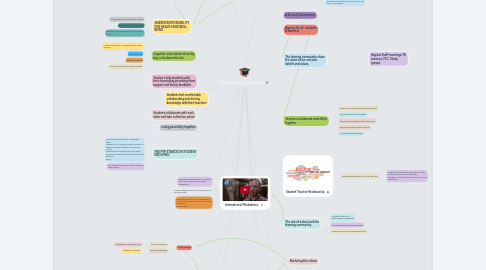The Learning Community
by Shikha Ahuja


1. SHARED RESPONSIBILITY FOR HEALTH AND WELL BEING
1.1. Home school communication journals
1.2. Mentoring for the Exhibition
1.3. Being an active participant in the students' learning
2. Living peacefully together
3. Linguistic and cultural diversity play a fundamental role
3.1. Active involvement of parents in their child's learning
3.2. Parent councils
3.3. Parent volunteers
3.4. Coffee Mornings and Parent evenings
4. Teachers help students with their learning by providing them support and timely feedback
5. Students feel comfortable collaborating and sharing knowledge with their teachers
6. Students collaborate with each other and take collective action
7. A Commitment to Inclusion
7.1. Teachers extend learning for all students by creating an affirmative and responsive environment that considers student identities and embraces learner diversity from a strength-based perspective.
7.2. Sharing responsibility and providing equal oppurtunities.
7.3. Inclusive support structure takes into consideration: Confidentiality, agency and self efficacy,a deeper understanding of learning differences
7.3.1. The impact of labelling students
7.3.2. Clearly stated policies
8. THE PYP STANCE ON STUDENT GROUPING
8.1. One of the IB approaches to teaching states: Teaching is inclusive and values diversity. It affirms students’ identities, and aims to create learning opportunities that enable every student to develop and pursue appropriate personal goals.
8.2. Recognize the need for strong nurturing relationships
9. International Mindedness
9.1. embracing multilingualism to enhance intercultural dialogue and global engagement.
9.2. focusing student inquiries on global human commonalities
9.3. creating opportunities for meaningful cultural exchange and action in the local and global communities
10. PYP leadership
10.1. Formal Leadership
10.1.1. Pedagogical Leadership Team
10.2. Informal Leadership
10.2.1. Student Leadership
11. Cultivating the Environment
12. Learning Environment
12.1. Resources
13. WHAT"S CHANGED? WHATS NEW??
13.1. Key Concepts
13.2. STAND ALONE SCIENCE AND SOCIAL STUDIES
13.3. http://blogs.ibo.org/sharingpyp/files/2018/02/2018-January-Learning-teaching-part-1-ENG.pdf
14. A commitment to collaboration
14.1. Common goal in supporting the transdisciplinary learning
14.2. Collaborative approach may vary in response to the local context and the needs of the learning community, and will always be based on a commitment to the mission of the IB and the PYP pedagogy.
15. A Shared Commitment
16. Agency for all- students & teachers
17. The learning community share the same vision, mission, beliefs and values.
18. Teachers collaborate and reflect together
18.1. Open communication and support network
18.2. Plan, assess and learn together
18.3. Professional dialogue is open and honest
18.4. Peer mentoring and Peer coaching
18.5. Co-teaching oppurtunities
19. Regular Staff meetings, PD sessions, PLC, Study groups
20. The commitment to Health and Well Being
20.1. Promote the importance of agency: voice, choice and ownership
20.2. Develop resilience to face challenges and change
20.3. Nurture positive mental health and well being
20.4. Identifying psychological barriers preventing students' learning
20.5. Recognize the need for strong nurturing experiences
21. Student Teacher Relationship
21.1. Teachers value students for who they are
21.1.1. Create lived experience to be able to relate to the child focusing on their their strengths, interests, perspectives, needs and aspirations
22. The role of school and the learning community
22.1. Creating a culture of international-mindedness
22.2. Providing professional development
22.3. Making provisions for language learning
23. Nurturing the school
24. COLLABORATION
24.1. Effective environment for Trans-disciplinary learning
24.1.1. Collaboration between grade level and subject level teachers

